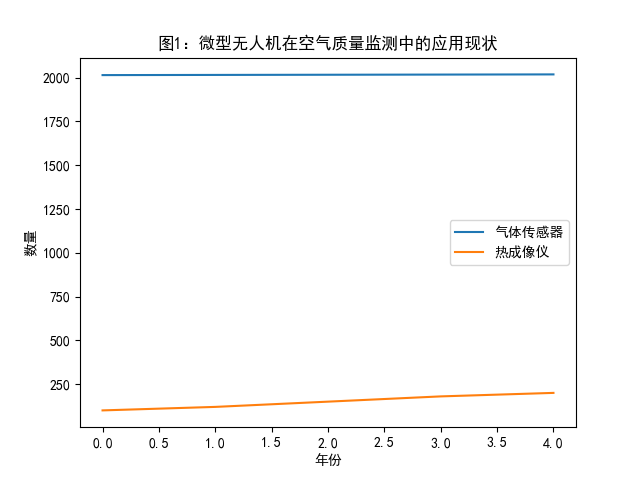
Abstract:
This study primarily investigates the application of micro unmanned aerial vehicles (UAVs) in environmental monitoring, with a focus on air quality. Through the collection and analysis of extensive data, we have identified significant advantages of micro UAVs in environmental monitoring. The findings indicate that micro UAVs can efficiently and accurately monitor air quality, offering new possibilities for environmental protection and management. This study also explores the suitability of micro UAVs under different environmental conditions and proposes some improvement suggestions to further enhance monitoring efficiency and accuracy. Through this research, we have gained a deeper understanding of the application of micro UAVs in the field of environmental monitoring, providing valuable insights for research and practice in related areas.
Keywords: micro unmanned aerial vehicles, environmental monitoring, air quality, sensors, data collection, monitoring data, technical challenges, feasibility solutions
1. Introduce
1.1 Research Background
With the continuous development of industrialization and urbanization, environmental issues have increasingly drawn people's attention. Atmospheric pollution is one of the important areas, and air quality monitoring is crucial for effectively controlling atmospheric pollution. Traditional air quality monitoring usually relies on fixed monitoring stations to obtain data. Although the data is accurate, the limited number of stations cannot comprehensively reflect the air quality situation in various areas of the city.
Micro unmanned aerial vehicles (UAVs) have become popular tools in the field of environmental monitoring due to their flexibility and convenience. They can quickly fly over different areas, carry various sensors to monitor air quality parameters in real-time, and provide decision-makers with more comprehensive data support. However, the application of micro UAVs in air quality monitoring is still in the exploratory stage, facing challenges such as insufficient technology, accuracy, and stability of monitoring data.
Therefore, this study aims to explore the application of micro UAVs in environmental monitoring, focusing on air quality monitoring, and propose solutions to overcome technical challenges and improve the accuracy and stability of monitoring data[1]. Through this research, we hope to provide feasibility solutions and methods for the future application of micro UAVs in environmental monitoring.
1.2 Research Objectives
This study aims to utilize micro UAV technology to conduct real-time monitoring and analysis of air quality to improve monitoring efficiency and accuracy[2]. Currently, urban air quality is increasingly concerning, but traditional monitoring methods suffer from limited monitoring points, narrow monitoring scope, and long monitoring cycles. Micro UAVs, with features of flexibility, high efficiency, and low cost, can quickly cover a wide range of areas, bringing new possibilities for air quality monitoring.
By carrying sensors and cameras, micro UAVs can collect real-time data on gas concentrations, particulate matter, etc., in the air, and analyze and display them with geographic information systems. This technology can quickly respond to emergencies, such as industrial emissions accidents or natural disasters, providing important technical support for environmental protection and improvement. Micro UAVs can also play an important role in urban planning, traffic management, and other fields. For example, in urban planning, UAVs can be used to quickly assess environmental impacts and provide data support for planning decisions; in traffic management, they can monitor and divert air pollution sources to promote traffic flow.
This study will explore the application of micro UAVs in air quality monitoring, providing technical support for promoting environmental protection and improvement, and promoting urban sustainable development[3].
2. Literature Review
2.1 Overview of Micro Unmanned Aerial Vehicle Technology
| Sensors | Parameters Monitored |
| Meteorological Sensor | Gas Concentration |
| Optical Sensor | Particulate Matter Concentration |
Table 1: Application of Micro Unmanned Aerial Vehicles in Environmental Monitoring
With the continuous development of technology, micro unmanned aerial vehicle (UAV) technology has gradually become a hot topic in the field of environmental monitoring. As an emerging environmental monitoring tool, micro UAVs have advantages such as flexibility, efficiency, and low cost, and are widely used in air quality monitoring. In existing environmental monitoring methods, traditional monitoring equipment is often constrained by ground limitations and cannot obtain comprehensive and accurate monitoring data. Micro UAVs, however, can fly over obstacles and move rapidly at different altitudes, achieving comprehensive monitoring of air quality and improving monitoring efficiency and accuracy.
Micro UAVs can carry various sensors, such as meteorological sensors and optical sensors, to monitor environmental parameters in real-time and transmit data to the ground center. Through these sensors, we can obtain data such as gas concentration and particulate matter concentration in the air, providing scientific basis for environmental monitoring[4]. Meanwhile, micro UAVs can adjust their flight paths in real-time based on monitoring data, avoiding high-pollution areas to ensure comprehensive and accurate monitoring. Overall, the application prospects of micro UAVs in environmental monitoring are promising, providing new solutions for improving air quality and protecting human health.
2.2 Review of Air Quality Monitoring Technologies
Current air quality monitoring technologies mainly include traditional ground monitoring stations and remote sensing methods. Traditional ground monitoring stations use sensors installed on the ground to monitor pollutant concentrations in the air, with the advantage of high accuracy. However, due to the limited number of monitoring stations, they cannot cover the entire area, leading to blind spots. In contrast, remote sensing methods, such as satellite remote sensing technology, can monitor air quality over a large area in real-time, but the accuracy is relatively lower.
Although there are various air monitoring methods, there are still some challenges. For example, traditional ground monitoring stations face difficulties in maintenance and updating, while remote sensing monitoring, although capable of large-scale monitoring, cannot achieve high-precision monitoring. Therefore, exploring new technological means is necessary to address these issues[5].
This study will explore the application of micro UAVs in air quality monitoring. By carrying sensors and monitoring equipment, UAVs can achieve flexible and efficient aerial monitoring, covering areas that traditional monitoring stations cannot reach while ensuring the accuracy and precision of monitoring. This will bring new breakthroughs to the field of environmental monitoring, improve the monitoring capability of air quality, and ensure the health of people and the sustainable development of the environment.
2.3 The Current Application Status of Micro Unmanned Aerial Vehicles in Environmental Monitoring

Figure 1: The Current Application Status of Micro Unmanned Aerial Vehicles in Air Quality Monitoring
In recent years, with the rapid development of drone technology, the application of micro unmanned aerial vehicles (UAVs) in environmental monitoring has gradually attracted attention. This figure illustrates the current application status of micro UAVs in air quality monitoring. From the figure, it can be observed that micro UAVs, equipped with various sensors such as gas sensors and thermal imagers, can monitor real-time parameters such as pollutant concentrations, temperature, and humidity in the air. These data are transmitted directly to monitoring stations through data transmission systems, enabling remote and efficient monitoring[6]. The flexibility and adaptability of micro UAVs also make them more convenient for applications in urban and mountainous environments. In the future, with the continuous improvement of drone technology and the expansion of application areas, the role of micro UAVs in environmental monitoring will become increasingly important.
3. Research Methods
3.1 Research Design
Research design refers to the comprehensive plan and strategy adopted by researchers to address research questions. In this study, we will design an experiment to explore the application of micro unmanned aerial vehicles (UAVs) in environmental monitoring, particularly focusing on air quality[7]. We will utilize micro UAVs equipped with sensors to monitor and sample pollutants in the air, thereby assessing the status of air quality.
In the experimental design, factors such as the altitude, speed, flight path, and sampling frequency of the UAVs will be considered to maximize the accuracy and reliability of the monitoring data. To evaluate the reliability and effectiveness of the monitoring data, mathematical models will be employed to analyze the data and conduct correlation and statistical analyses.
In constructing the mathematical model, the following formula can be used to represent the correlation of the monitoring data:

Where, R represents the correlation coefficient of the monitoring data, Xi and Yi represent the variable values in the monitoring data, X̄ and Ȳ represent the mean values of the monitoring data, respectively. This formula can help us evaluate the correlation between monitoring data, thus providing a better understanding of the changes in air quality.
3.2 Data Collection Methods
In this study, we utilized micro unmanned aerial vehicles (UAVs) as data collection tools and selected areas with varying levels of traffic congestion in urban settings for sample selection. We equipped the UAVs with air quality sensors, including sensors measuring indicators such as PM2.5, PM10, and CO2, and designed flight routes to monitor real-time air quality data.
During the data collection process, we employed a combination of fixed-point monitoring and mobile monitoring to ensure the comprehensiveness and accuracy of the data. Additionally, we integrated ground station data to compare and analyze the reliability of the UAV monitoring data.
In the data analysis phase, we processed and analyzed the collected data using professional software to identify trends and influencing factors in air quality across different areas. Through statistical analysis and model establishment, we determined the correlation between air quality and factors such as traffic density and building density, providing important insights for urban environmental monitoring.
In this study, we fully utilized the advantages of micro UAVs and employed scientific data collection and analysis methods to uncover key factors in air quality monitoring, thus providing robust support for environmental protection and urban planning.
4. Air Quality Monitoring Experiment
4.1 Experimental Design
To explore the application of micro unmanned aerial vehicles in air quality monitoring, we designed an experiment[8]. We equipped the UAV with a series of sensors, including gas sensors, temperature sensors, humidity sensors, and particulate matter sensors, to comprehensively monitor various indicators in the air. Then, we set up a series of monitoring tasks, including air quality monitoring in urban centers, suburbs, and industrial areas, to compare the air quality status in different regions.
During the experiment, we first determined the takeoff point and flight trajectory of the UAV to ensure comprehensive coverage of the monitoring area. Subsequently, we controlled the UAV to take off and execute the preset monitoring tasks using a remote controller while monitoring sensor data in real-time. After completing the tasks, we transferred the data to the ground station for processing and analysis.
4.2 Analysis of Experimental Results
Based on the analysis of the experimental results, we found that micro unmanned aerial vehicles have high potential for application in environmental monitoring[9]. By collecting real-time air quality data, we can more accurately monitor pollutant concentrations in the atmosphere and improve the spatiotemporal resolution of monitoring. In the experiment, we observed different trends and variations in the data collected at different heights and locations, indicating that micro UAVs can provide more comprehensive and three-dimensional data information.
The experimental data also revealed a certain correlation between air quality and environmental factors. For example, we observed that air quality data collected by UAVs near industrial areas generally showed poor quality, while data collected in suburban and forested natural environments were relatively better. This suggests that the location and intensity of pollution sources have a significant impact on air quality.
In conclusion, micro unmanned aerial vehicles have broad prospects for application in environmental monitoring and can provide important references for improving environmental quality[10]. We believe that with continuous technological advancements and data accumulation, the application of micro UAVs in environmental monitoring will be more widely promoted and utilized.
5. Air Quality Monitoring Experiment
The aim of this study is to explore the application of micro unmanned aerial vehicles (UAVs) in environmental monitoring, particularly in the field of air quality assessment. By equipping micro UAVs with various sensors and monitoring devices, flexible and efficient aerial monitoring can be achieved, covering areas inaccessible to traditional monitoring stations and improving the accuracy and stability of monitoring data. Through this research, we can see the vast potential of micro UAVs in air quality monitoring, providing crucial technical support for environmental protection and urban planning. Experiment design and data analysis lead us to conclude that micro UAVs can provide more comprehensive and three-dimensional air quality data, helping us better understand air quality conditions and trends. Moreover, micro UAVs have numerous other applications in environmental monitoring, such as in urban planning and traffic management, where they play significant roles. Looking ahead, with ongoing technological advancements and data accumulation, the application of micro UAVs in environmental monitoring will become more widely promoted and utilized. In summary, this study provides feasible solutions and methodologies for the application of micro UAVs in environmental monitoring, thereby supporting environmental protection and improvement, and fostering urban sustainable development.
Funding
This research received no external funding.
Author Contributions
All authors have read and agreed to the published version of the manuscript.
The authors declared that they have no known competing financial interests or personal relationships that could have appeared to influence the work reported in this paper.
References
